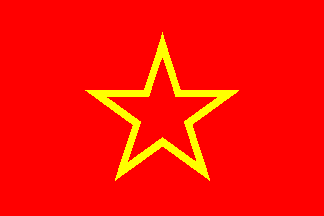H-Town Tejas

| |
| Flag of H-Town Tejas | |
| Motto: All Your Women Are Belong To Us! | |
| No Map Available Yet | |
| Region | Japan |
|---|---|
| Capital | New Fukuoka |
| Official Language(s) | English, Español, Nihongo |
| Leader | Interim Council of the PRH-TT |
| Population | 4,150,000,000 (as of 10/20/07) |
| Currency | 10mm Slug |
| NS Sunset XML | |
The People's Republic of H-Town Tejas (Spanish: República Popular de H-Town Tejas, Japanese: エイチュタウンテハス人民共和国, Eichutaun Tehasu Kyōwakoku) is a large socialist state that replaced the government of the Social Republic of Texas after a brutal guerilla war. The nation, under the leadership of Nagaraku Ryouta and the Tejano Worker's Party, has recovered from the destructive rule of the SRT and is now a major nation in the Communist world.
Geography
H-Town Tejas is swampy and humid almost all over the country, the exceptions being the deserts in the East and the hills in the Dallas Exclave. Enemies of the PRH-TT and locals alike call it the "Polluted Swamp." This is because of the widespread pollution caused by the SRT. Tejas has two seasons, "hot," which goes up to 125 degrees Fahrenheit, and "cold," which usually doesn't go below 50. It is usually extremely rainy the whole time.
History
H-Town Tejas was originally settled by Japanese people at New Fukuoka, a port in South Tejas, followed by other Asians (mainly Vietnamese and Chinese). However, soon Europeans settled the rest of the place, some as prison colonies, others just for the sake of being imperialist. One colony decided that it wanted independence, so it rebelled against its oppressors and won independence for itself, calling itself the "Empire of Texas," with its capital at some city called Austin. The Empire invaded all of its neighboring Tejano colonies and increased the nation's size to more that how large it is today.
Eventually, the people became dissatisfied with the monarchy. In 1883, protests forced the indecisive King William Robert Joseph V to step down and form the "Republic of Texas." The Republic was ruled by conservative Christian leader Alois Almstedt, who formed a de facto one-party state upon being elected. Catholics had to endure moderate discrimination, and Latinos, Asians, and people who followed Asian religions got it even worse. The death of Almstedt in 1899 did not end his reign of terror, and officials from his party ruled until 1939, when the Worker's Revolution, a series of trade union-inspired protests took place all across the country. However, their leader Bùi Ánh, a somewhat uninspiring Vietnamese labor leader in Austin, was more than a little ineffective at ruling the country. The military, which was all but completely out of the new government's hands, deposed Ánh in 1940.
The general leading the coup, Alejo Suárez Trejo, had simply wanted to end the period of instability caused by Ánh's government. However, his rule turned out to be the most brief rule in Tejano history; Suarez was ousted by a coup 5 hours later by fascist troops led by Brigadier General Aurelius Christensen. Christensen named himself president-for-life of the harshly anti-Communist, harshly white supremacist, and above all, harshly oppressive in general Social Republic of Texas. Austin was quickly renamed after the person all Asians and Latinos didn't want it to be named after; Christensen himself. The Social Republic dwarfed even Almstedt's regime in brutality and discrimination. By the '80s, the people had had enough.
A New Fukuoka factory worker named Fujita Ichirou and his friend Nagaraku Ryouta organized a bunch of dissatisfied workers against the SRT and its current president, Brand Christensen. The Tejano Proletariat Army, a left-wing guerilla army, was formed and took over all of New Fukuoka in 1987. New Fukuoka province was thrown into massive chaos, followed by the rest of the country. The TPA was on the verge of victory when the UN intervened. Peacekeepers imposed UN administration. President Christensen fled the country with the assistance of the UN, while Fujita Ichirou was killed in a fight with UN peacekeepers. Nagaraku Ryouta took over the TPA and, after ten total years of fighting, the TPA had finally outlasted the UN, who pulled out.
Fujita Ichirou was an avid democratic socialist, so high-profile leaders of the TPA drafted a constitution identical to his ideals. However, this didn't work; upper-class people and SRT supporters violently protested against the new Republic of H-Town Tejas.This was especially reflected in the Dallas Exclave, which rebelled and formed a de facto fascist state. Ryouta Nagaraku, then Prime Minister, wasn't having any of that. Not more than a year after the RH-TT's formation, he drafted an act that reformed the fledgling republic into an autocratic socialist state called the People's Republic of H-Town Tejas, with him at its head as "Chairman of the Tejano Worker's Party."
Today's Tejas
Chairman Nagaraku doesn't have as much faith in democracy as Fujita did, and the PRH-TT is a dictatorship now. The people have more civil rights than some democracies, but they have no real authority over who rules them. Most Tejano parties are puppets, totally controlled by the TWP, and the rest are illegal.
The PRH-TT's Dallas Exclave was filled with SRT supporters, and as a result has a whole lot of secessionists in it. The TPA Dallas Garrison, as a result, is the most well-equipped section next to the Military Internal Bureau in the Tejano Proletariat Army. The PRH-TT faces a lot of fascist terror in its mainland as well, due to the ex-People's Security Minister Celino Aiza's crushing of a riot outside the capitol. Chairman Nagaraku was almost assassinated, and his wife Nagaraku Akemi was. Currently, however, the PRH-TT economy seems to be on the rise, and it seems to be doing fine.
